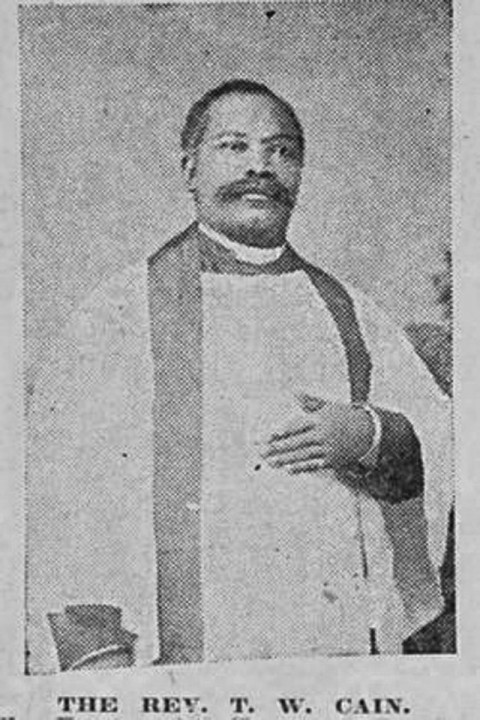Texas churches discover pioneering Black Episcopal priest's unmarked grave

For decades members of the three Episcopal churches in Galveston, Texas–Trinity, Grace and St. Augustine of Hippo–have wondered about the location of Thomas White Cain’s grave. Cain, who is recalled as much for his life and ministry as for his death, was priest-in-charge of St. Augustine’s when he died on September 8, 1900, in the Great Galveston Flood. Earlier this month, they found it.
The hurricane killed at least 6,000 people and destroyed or damaged almost every structure in town. After the waters receded, Cain’s body was found on the beach and hastily buried. Later that year his remains were moved to Galveston’s Lakeview Cemetery, where then-Texas Bishop George Kinsolving officiated at the burial. His wife Elizabeth’s remains were never found. But the location of Cain’s grave was lost to memory over the decades, and a headstone, like others from that era, was likely destroyed or crumbled over time.
In mid-February, a combination of longtime close ties between the three churches and a bit of luck turned up Cain’s final resting place, said Jimmy Abbott, Trinity’s rector. The three churches raised enough money in one day through a social media campaign to pay for a stone grave marker, which St. Augustine’s is designing.
All three churches are located within a mile of each other, and while they have different histories and cultures, they have always worked together. “There was a line from an old Galveston civic leader who said that people who may die together learn to live together,” Abbott said.
It all began with Trinity.
Grace’s rector, Jonathan Totty said by email that his church was a mission started by Trinity in 1876, but when African-Caribbean sailors working at the Port of Galveston sought to attend church there on Sunday mornings, they were offered services on weekdays or Saturdays instead. Disillusioned, they bought an old church building and started St. Augustine’s in 1884. And when Grace’s current church building was dedicated in 1894, Cain was present.
The luck part of the story came when a Trinity vestry member, who owns an antique shop and is married to a vestry member at St. Augustine’s, discovered a document listing the grave plots in Lakeview Cemetery, including Cain’s. Working with the cemetery manager and cross-referencing names on the list with existing headstones, they were able to locate the unmarked grave.
While Cain’s death was tragic, his life was remarkable. Historical information from the Episcopal dioceses of Texas and North Carolina, along with accounts from noted Black historian George Freeman Bragg—who was Cain’s first cousin—show Cain was born enslaved in 1843 in Warrenton, North Carolina, and by the end of the Civil War he and other members of his family had moved to Petersburg, Virginia, where they were connected to Grace Church, now Christ and Grace, where his father was a sexton.
Because it was illegal to teach enslaved people to read or write, Cain, now free, had his first exposure to education at age 22 at the Freedman’s Commission School started by St. Stephen’s Church in Petersburg. He excelled and went on to Lincoln University in Philadelphia. After graduating he studied at the Philadelphia Divinity School, left school to teach for a few years, and then resumed studying for ordination at the Bishop Payne School in Petersburg, a branch of Virginia Theological School started specifically to prepare Black men for ordained ministry.
Cain was the first Black man in the state of Virginia to become a candidate for Holy Orders, less than 15 years after the end of the Civil War. He was ordained in 1879 by Virginia Bishop Francis Whittle and served St. Philip’s in Richmond until being called in 1888 to St. Augustine of Hippo in Galveston, the oldest Black church in Texas.
The bishop who called him there, Alexander Gregg was an enslaver before the war. Cain became the first priest of color to serve in the Episcopal Diocese of Texas and, later, the first Black priest to serve in the House of Deputies.
Cain also fought against a Jim Crow-era Texas law that required segregated train coaches. In 1893 he was traveling home from St. Louis when he was told he had to leave his Pullman sleeping car for a Blacks-only coach. He later sued both the Pullman Company and the railroad. A local court awarded Cain $100 in damages.
After Cain’s death, John Pollard, his longtime friend and the archdeacon in North Carolina, wanted to honor Cain’s life and ministry by building a new church for the historically Black All Saints Parish in Cain’s hometown of Warrenton, and he set about raising money from Black Episcopalians across the country.
North Carolina Bishop Joseph Cheshire laid a cornerstone memorializing Cain in 1914. A century later the building closed, though the Diocese of North Carolina is restoring All Saints, which also is known as Thomas Cain Memorial Church.
The Diocese of Texas honors Cain with The Rev. Thomas Cain Fund for Historic Black Churches. It provides annual grants for the mission, programming, or maintenance of the historic Black churches in the diocese. —Episcopal News Service



